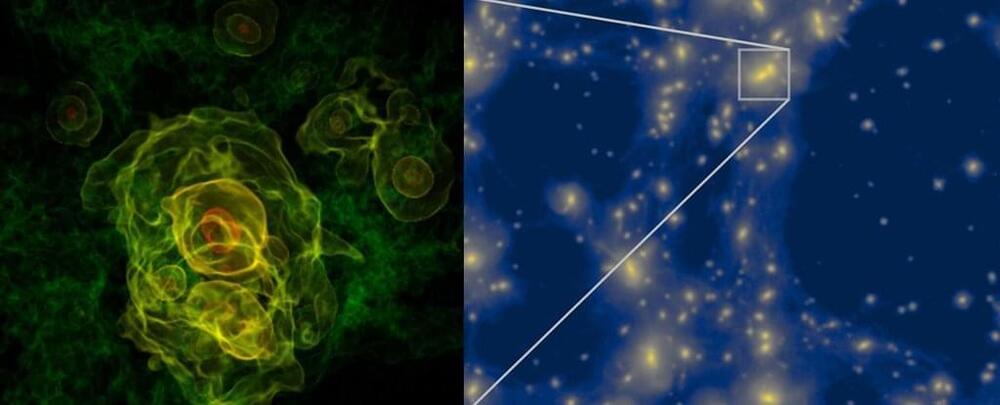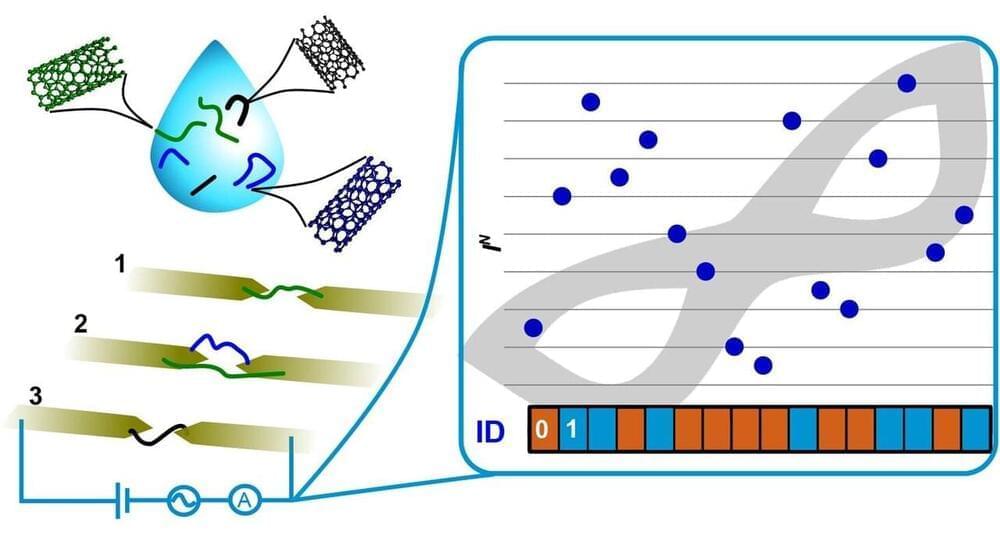Tech giants including Alphabet and IBM are racing toward building a quantum computer, and financial firms including JPMorgan are exploring possible uses.
Category: quantum physics – Page 623

Physicists Have Simulated The Primordial Quantum Structure of Our Universe
Peer long enough into the heavens, and the Universe starts to resemble a city at night. Galaxies take on characteristics of streetlamps cluttering up neighborhoods of dark matter, linked by highways of gas that run along the shores of intergalactic nothingness.
This map of the Universe was preordained, laid out in the tiniest of shivers of quantum physics moments after the Big Bang launched into an expansion of space and time some 13.8 billion years ago.
Yet exactly what those fluctuations were, and how they set in motion the physics that would see atoms pool into the massive cosmic structures we see today is still far from clear.

The best of both worlds: Combining classical and quantum systems to meet supercomputing demands
Quantum entanglement is one of the most fundamental and intriguing phenomena in nature. Recent research on entanglement has proven to be a valuable resource for quantum communication and information processing. Now, scientists from Japan have discovered a stable quantum entangled state of two protons on a silicon surface, opening doors to an organic union of classical and quantum computing platforms and potentially strengthening the future of quantum technology.
One of the most interesting phenomena in quantum mechanics is “quantum entanglement.” This phenomenon describes how certain particles are inextricably linked, such that their states can only be described with reference to each other. This particle interaction also forms the basis of quantum computing. And this is why, in recent years, physicists have looked for techniques to generate entanglement. However, these techniques confront a number of engineering hurdles, including limitations in creating large number of “qubits” (quantum bits, the basic unit of quantum information), the need to maintain extremely low temperatures (1 K), and the use of ultrapure materials. Surfaces or interfaces are crucial in the formation of quantum entanglement. Unfortunately, electrons confined to surfaces are prone to “decoherence,” a condition in which there is no defined phase relationship between the two distinct states.

Multiparty entanglement: When everything is connected
Entanglement is an ubiquitous concept in modern physics research: it occurs in subjects ranging from quantum gravity to quantum computing. In a publication that appeared in Physical Review Letters last week, UvA-IoP physicist Michael Walter and his collaborator Sepehr Nezami shed new light on the properties of quantum entanglement—in particular, for cases in which many particles are involved.
In the quantum world, physical phenomena occur that we never observe in our large scale everyday world. One of these phenomena is quantum entanglement, where two or more quantum systems share certain properties in a way that affects measurements on the systems. The famous example is that of two electrons that can be entangled in such a way that—even when taken very far apart—they can be observed to spin in the same direction, say clockwise or counterclockwise, despite the fact that the spinning direction of neither of the individual electrons can be predicted beforehand.
Artificial General Intelligence | Tim Ferriss & Eric Schmidt | GEONOW
✅ Subscribe: https://bit.ly/3slupxs.
Quantum AI is the use of quantum computing for computation of machine learning algorithms. Thanks to computational advantages of quantum computing, quantum AI can help achieve results that are not possible to achieve with classical computers.
Quantum data: Quantum data can be considered as data packets contained in qubits for computerization. However, observing and storing quantum data is challenging because of the features that make it valuable which are superposition and entanglement. In addition, quantum data is noisy, it is necessary to apply a machine learning in the stage of analyzing and interpreting these data correctly.
Quantum algorithms: An algorithm is a sequence of steps that leads to the solution of a problem. In order to execute these steps on a device, one must use specific instruction sets that the device is designed to do so.
Quantum computing introduces different instruction sets that are based on a completely different idea of execution when compared with classical computing. The aim of quantum algorithms is to use quantum effects like superposition and entanglement to get the solution faster.
Why is it important?
Although AI has made rapid progress over the past decade, it has not yet overcome technological limitations. With the unique features of quantum computing, obstacles to achieve AGI (Artificial General Intelligence) can be eliminated.
The lab will work in areas such as quantum computing
The lab will work in areas such as quantum computing, explainable artificial intelligence (AI) that presents data in a manner that can be understood by humans, and Metaverse, a virtual world where people can connect through their digital avatars.
Tech Mahindra already has 10 Makers Lab across the world and the new unit at Mahindra University will be the 11th facility globally and second in Hyderabad, said the company.
“With the launch of Makers Lab, we will provide many talented and skilled individuals, with the opportunity to progress for a greater cause,” said CP Gurnani, MD & CEO, Tech Mahindra.

TechM, Mahindra University’s new lab to focus on metaverse, quantum computing research
IT major Tech Mahindra (TechM) and Mahindra University have signed a memorandum of understanding (MoU) to set up a new ‘Makers Lab’ for research and development. The lab will work in areas such as quantum computing, explainable artificial intelligence (AI) that presents data in a manner that can be understood by humans, and Metaverse, a virtual world where people can connect through their digital avatars.
Tech Mahindra already has 10 Makers Lab across the world and the new unit at Mahindra University will be the 11th facility globally and second in Hyderabad, said the company.
“With the launch of Makers Lab, we will provide many talented and skilled individuals, with the opportunity to progress for a greater cause,” said CP Gurnani, MD & CEO, Tech Mahindra.
On black holes, holography, the Quantum Extended Church-Turing Thesis, fully homomorphic encryption, and brain uploading
I promise you: this post is going to tell a scientifically coherent story that involves all five topics listed in the title. Not one can be omitted.
My story starts with a Zoom talk that the one and only Lenny Susskind delivered for the Simons Institute for Theory of Computing back in May. There followed a panel discussion involving Lenny, Edward Witten, Geoffrey Penington, Umesh Vazirani, and your humble shtetlmaster.
Lenny’s talk led up to a gedankenexperiment involving an observer, Alice, who bravely jumps into a specially-prepared black hole, in order to see the answer to a certain computational problem in her final seconds before being ripped to shreds near the singularity. Drawing on earlier work by Bouland, Fefferman, and Vazirani, Lenny speculated that the computational problem could be exponentially hard even for a (standard) quantum computer. Despite this, Lenny repeatedly insisted—indeed, he asked me again to stress here—that he was not claiming to violate the Quantum Extended Church-Turing Thesis (QECTT), the statement th at all of nature can be efficiently simulated by a standard quantum computer. Instead, he was simply investigating how the QECTT needs to be formulated in order to be a true statement.

Fighting counterfeit with carbon nanotubes
The ubiquity of electronic devices makes it essential to use encryption and anti-counterfeiting tools to protect the privacy and security of users. With the growing expansion of the Internet of Things, protection against attacks that violate the authenticity of products is increasingly necessary. Traditionally, message protection has been based on different systems: passwords, digital signatures or encryption. This cryptography is based on unknown keys to a possible attacker, but unfortunately these systems are becoming obsolete as new more invasive attacks appear: malware, API attacks or physical hardware attacks.
While quantum computing slowly progresses towards the cryptographic paradigm, the so-called physically unclonable functions (PUFs) are presented as the choice to ensure unique and effective identification. A PUF is a device that has unique and non-repeatable physical properties that can be translated into usable bits of information. The idea of applying random physical characteristics to identify systems or people is not new: for example, the identification of individuals using the fingerprint dates from the 19th century. More recently, the identity of electronic devices has been established using PUFs, which are “electronic fingerprints” of an integrated circuit.
Authentication based on PUFs comprises a chip manufactured by intrinsically random processes that make cloning almost impossible, even though all the details of the manufacturing process are known. The measurements of the various physical properties of the PUF depend on the properties of the chip at the nanoscale, thus constitute a very powerful anti-fraud and anti-counterfeiting technology. To be implementable at an industrial level, this chip must be low cost, scalable and its properties must be easily measurable by means of an identifiable function.
